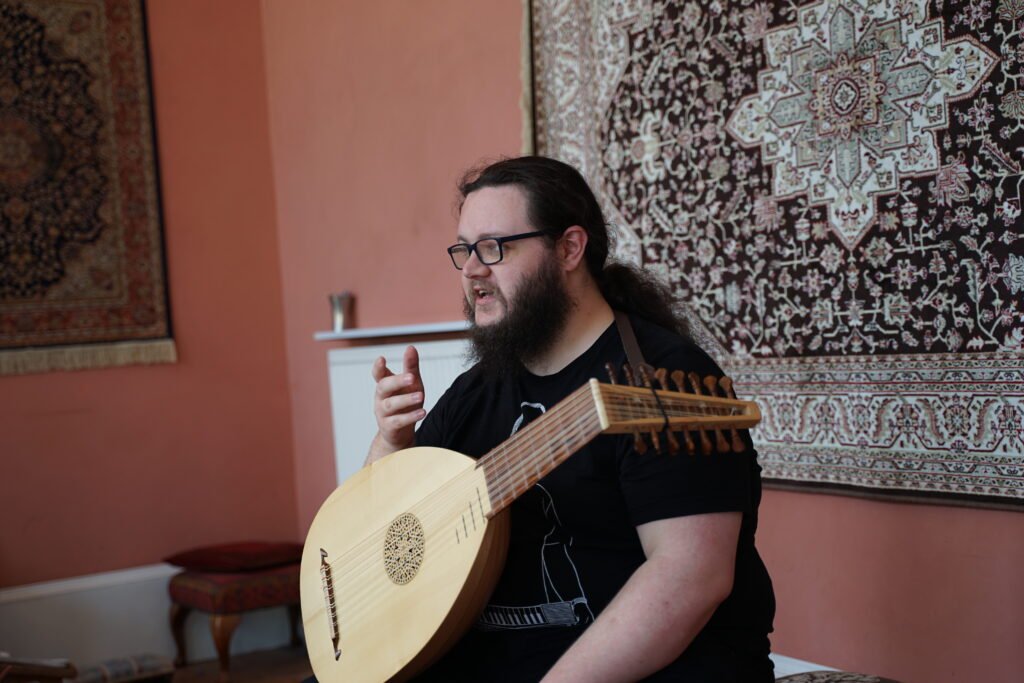Report of Meeting – 06/07/22
After our last extended meeting, which included a talk, concert, and prosecco and cake, this was slightly shorter, featuring our regular meeting, coffee and cake, and a lecture recital. We welcomed old and new members, with people coming equally with instruments to perform, and without to just enjoy the music and cake! Funds were raised to help bring further guest speakers in the future.


Glen once again opened our meeting performing a mixture of German, Italian, and French repertoire on his 8 course EMS lute. First, he performed Margraffer dantz from a Swiss manuscript(CH-Bu. FII)showcasing his trademark ornamentation and arpeggiation, highlighting the rhythmic character of the dance. He then this followed this with Basso del Ninfe, delightfully balancing the bassline and melody of this beautiful tune by Cesare Negri. Finally, he took us to France with an intabulation of Las las porquoy, found in Pierre Attaingnant’s first ever lute publication of 1529. The contrapuntal three voice texture could be heard clearly and projected with a strong sound; Glen’s playing continues to improve at every meeting!

Next to play was Foster Ross, who delighted us by bringing his beautiful 11 course baroque lute made by Malcom Prior. He opened with two tunes, Lilly ballino and The king enjoys his own again, from one of SLEGS favourite sources, the Balcarres lute book. In his performance he displayed his nimbleness on the bass courses of the instrument, carrying confidently both bass and the melody of each piece. He followed with a Prelude from a Sonata in C Major by S.L. Weiss, displaying his excellent righthand technique realising the arpeggiated textures of the dense harmonies.

We were pleased to welcome Alastair Merrill who attended his first meeting. While at first a little shy to play, after revealing he studies with renowned lutenist Jacob Heringman he was coaxed into playing a couple of tunes! He sight-read for us Callerno custure me from the William Ballet lute book, and a Dance by Hans Newslider. While he had little preparation, he deftly dispatched the chords found in Callerno custure me, and impressively realised the two-part contrapuntal texture of Newslider’s dance! We look forward to hearing much more from Alastair, especially with a chance to practice!

Finally, Lusia McMinn once again played for us a tune on her James Marriage theorbo. Continuing her way through Francesca Torelli’s Tutor for Theorbo, she performed Alessandro Piccinini’s famous Ciccona. Luisa managed to convey the original spirit of the, mixing strumming, counterpoint, and florid campanella passages to produce a convincing performance. It was so good she was asked to play it again, and to the delight of the audience she did!

After the coffee and cake, where members had a chance to talk and try each other’s instruments, performer and researcher Eric Thomas gave his lecture recital Dalza’s Dictionary of Dance. To open Eric gave some brief context about the literary debates and performance at the opening of the sixteenth century in Italy. Writers were concerned whether to use dialects or the classical trecento Tuscan of Dante, Petrarch, and Boccaccio for the written word, while performers such as canterini used the written word in creative ways to constantly produce new semi-improvised performances. Eric then suggested how Dalza’s print when seen in this light, can be used to produce your own dances from the material given by Dalza. Eric played various examples from both Dalza’s Libro quarto and the Capirola Manuscript. Vital funds were raised to help bring new guests to our meetings, which we agreed we are looking forward to!